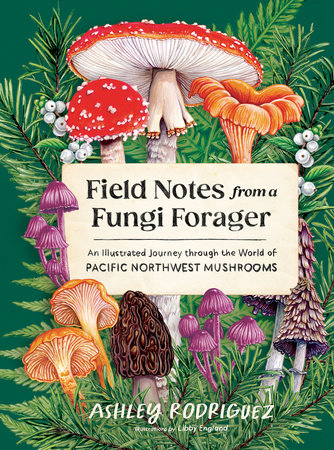Introduction
I contend that the planet’s health actually depends on our respect for fungi.
—Paul Stamets
As a child growing up in the Pacific Northwest with conifer-studded woodlands as my backyard, I spent hours creating worlds out of decaying logs, snacking on tart red huckleberries, picking wildflowers—and avoiding mushrooms. There was very little motivation to befriend the fungi. I was terrified they could kill me, and when they did appear on my dinner plate I was grossed out by their slimy presence.
Fast-forward a couple of decades and now I’m loud and proud about my fungi fandom. There were many encounters along the way that led to this dramatic shift in my relationship with mushrooms, some of which you’ll read about in the following pages. The thing about fear is that with knowledge, curiosity, and listening, it can transform into wonder and awe. Once I started to understand fungi more, my appreciation of them has exploded. It began as a desire to enjoy eating them. As a chef and recipe developer, I wanted to expand my palate and overcome my aversion to mushrooms, so I started to add them to dishes, first by chopping them up very finely so I wasn’t overwhelmed by the texture and instead could focus on the earthy, umami-rich flavor. Eating wild mushrooms was a much different experience than dodging the button mushrooms from my childhood. I went from avoiding mushrooms to spending hours and hours in the woods trying to find them. Now, I delight in seeing any and all mushrooms (not just the edible ones). A walk in the woods with me means that our conversation will always be interrupted by mushroom sightings.
That is essentially the premise and purpose of this book: to share my knowledge and love of the fungal world so that mushrooms can get the appreciation they rightly deserve. I’m honored to be your co-guide, along with the fungi, on this journey. I am a passionate forager and have been for many years. I have had the distinct pleasure of being guided by some of the best and most knowledgeable mushroom experts in the field. I’m also a nature-therapy and eco-spiritual guide, and I’ve been working in the food world for over two decades. Initially, I came to love foraging for the incredible ingredients the woods could provide, but the more I learn, the more I appreciate fungi for the inherent wisdom, beauty, medicine, and healing they provide to the entire ecosystem.
***
This is not a foraging guide. It’s not meant to be a scientific tome used for proper identification in the field. There are many incredible resources out there for that (my recommendations are listed on page 000). Rather, this is for the open-minded ones who are eager to learn a little bit about the hidden knowledge that fungi possess and their role in the interconnection of life, all centered in the beautiful and fertile ground of the Pacific Northwest. Our journey through the world of fungi aims to dispel misconceptions and replace them with delight, awe, wonder, and a little bit of whimsy.
We’ll begin by learning more about how fungi function and interact with the natural world, including ourselves. We’ll touch on current research about how mushrooms are helping to save the planet and our mental health. We’ll look at the ecosystems and ecology of the Pacific Northwest and its lush and welcoming habitat for many species. Next, we’ll cover best practices for foraging or simply going out for a mushroom appreciation hike or wander.
The bulk of the book is a collection of field notes from the forest floor: an exploration of the many different types of mushrooms that call this special region home, from the famous
Morchella (morel, pages 000–000) and
Cantharellus (chanterelle, pages 000–000) to the lesser-known species that are equally fascinating, like the bluish-purple
Lepista nuda (wood blewit, page 000) and
Hydnellum peckii (bleeding tooth fungus, page 000), which oozes brilliant red droplets. Here, we’ll befriend each of these mushrooms by getting to know their appearance and what distinguishes them from other species, and we’ll look at how some of them have been used throughout different cultures and in stories or myths.
This book is an ode to the fungi among us, a celebration of the natural world and the magic that can be found in even the smallest things. Through the lens of these humble fungi, we’ll explore the interconnectedness of all living things and gain a deeper appreciation for the beauty and complexity of our bioregion. Whether you’re a seasoned forager or just starting to appreciate the beauty of mushrooms, there’s something in these pages for everyone. Allow the scent of damp earth and the sight of vibrant caps, hidden mycelial webs, and puffs of smokelike spores be our guide.
Copyright © 2024 by Rodriguez, Ashley. All rights reserved. No part of this excerpt may be reproduced or reprinted without permission in writing from the publisher.












